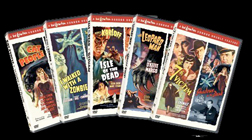
BUY IT AT AMAZON:
CLICK HERE!
STUDIO: Warner Bros.
MSRP:
$19.97
RATED: NR
RUNNING TIME: 72/79 mins.
SPECIAL FEATURES: Commentary
by Film Historian Tom Weaver on Bedlam
Note: Save some of your hard-earned dollars by purchasing the entire Val Lewton Horror Collection (click here). You won’t be sorry.
For more Lewton, check out my Leopard Man/Ghost Ship review here and Thor’s review of I Walked With A Zombie/The Body Snatcher here.
Val Lewton continued on his psychological Horror Express through the late 40’s, this time taking along with him a by-product of the Classical Universal Horror period: Boris Karloff (their third collaboration – The Body Snatcher, is on the disc coupled with I Walked with a Zombie). The imposing man whose features were etched out by the most sordidly intriguing machinery behind the eyes seemed like a lock to tackle the relatively sparse tales of Horror that Lewton provided to a salivating public. Only thing was, Lewton wasn’t particularly thrilled with RKO imposing an actor of such notorious roles as Mummies and brain-dead Heavies on him. True to form, Lewton had previously expounded against the Universal system, basically calling their films out as tawdry entertainment, not his cup of twisted minds and sneaky shadows. But, as it turned out, both visionaries needed each other as much as you need to see them. Right now.
The Flick(s)
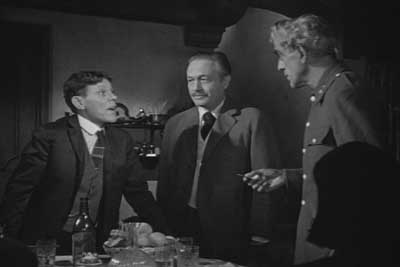
"I’ll do almost anything, except that Hag of a wife of yours…"
On the great commentary track from Film Historian Tom Weaver, he explains that Lewton was entirely unsure about Karloff’s abilities for the first of their collaborations – Bedlam. However, Karloff was more or less inspired immediately, and suddenly, the man who was infamous for butting heads (such as on House of Frankenstein, a movie I find hilariously campy and frightening at the same time. Especially when Karloff’s Assistant slowly moves in for a kill with his ragged hands for three hundred minutes.) with previous directors was now making notations in his script and bouncing off ideas back and forth almost as if he was invigorated by this new freedom Lewton allowed him to have under the watchful eye of his actor’s whip.
The first film on the disc is that of Isle of the Dead. Allegedly inspired from an artist that absolutely no one who reads this website knows about (including myself!), the plot starts forebodingly during one of the worst wars in Greek history. During this time (1912) we learn of the evil spirit known as the Vorvolaka, a demon-like creature that strikes without warning, almost like a Swedish-made car on a Christine-like bender. Except that in the Vorvolaka’s case, you might actually live. At the current moment, the events that are unfolding are the Greek Army’s stubborn refusal to actually die in the face of their enemies. Instead, they’re succumbing to the ravages of war: plague, typhus, and the craziness that engulfs men when they don’t win during Wolfenstein.
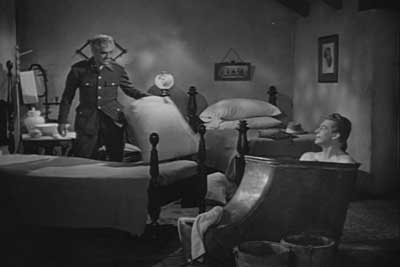
"Yes, but that still doesn’t explain why you’re bathing in a shoe!"
Boris Karloff and his tuft of Robert Plant-like hair are General Nikolas Pherides, the type of man who coldness means the utmost warmth and dignity inside his steely veneer. In a shocking opening, Karloff gives a Man a gun to kill himself, since very obviously, he’s shamed the good graces of his watchdog status and the Army itself. This is a man, we’re told, "who would kill his wife and child for countries’ sake." Ironic, considering that Karloff’s wife has been dead for quite some time, and as fate would have it, is dead and buried around the same area he and his troops are fighting in: an Island that also happens to be one large Cemetery. Custom observes that he must take the pilgrimage once and a while to give his cold-hearted respects to his wife’s tombstone (it reads: cheese and pepperoni). However, there’s this thing – a nasty plague – subsequently making the rounds on the battlefield, sparing absolutely nothing (like unwashed penises) in its wake.
That doesn’t stop him from commandeering a small sail boat to the Isle with a Boston War Correspondent, that of Olivier Davis (Marc Cramer) – without even a tiny hint of a Boston accent anywhere near his personage. The Island is a rather mystical place, complete with a very welcoming statue of the Vorvolaka on its shores, so it’s only a natural course of events that the duo takes the high road towards a strange homestead overlooking the ravages of war.

"Maybe you and your hair should consider Beakman’s World…"
What’s odd is that there’s a multi-international group living in this house. One’s an Archeologist studying the Island’s history, the other a Doctor who is investigating something or other, another is an Old Woman who loves her some séances and conjuring the Vorvolaka, and even another is a ravishing young woman by the name of Thea who seemingly makes Karloff’s blood boil a little hotter whenever she’s in his presence. The point remains, though, that it’s not really fully explained why this group of people happened to just congregate completely in each other’s company. Granted, they do make it seem interesting (in a kind of "just passin’ through" sort of way), but in the end, I felt that this rag-tag group of mercenaries from Death sort of served as this tremendous plot device in order to keep Karloff and Cramer on the Island once the plague makes its first entrance.
Which it does. Naturally, the Doctor takes the necessary precautions to ward off the slowly coming evil, like a train moving 5 MPH that you know will crash, but there’s not much you can do about it. Like those goddamned monthly bills. But as the plague shakes its beat-down stick against the group, which even includes our heroes (since, reinforcing that Lewtonesque notion of fate and how no one is safe), there even happens to be a little mystery in the house, courtesy of the Vorvolaka and his diabolical, evil ways. You see, the three-headed demon happens to have his grimy paws in more than a few items of doom. And all roads might lead to Death, unfortunately.
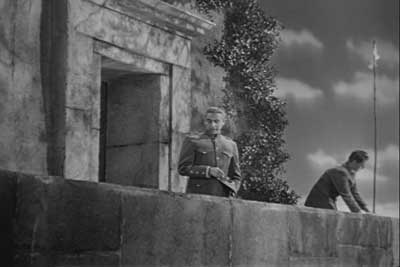
"You don’t need to raise the flag to let
everyone know I’m a virgin, Harry…"
What is fortunate is the cast, which rallies around an ailing Karloff (he was going through a painful back operation at the time, which made this picture stop-and-start faster than your furious masturbating sessions last night.) to bring forth a centralized hive mentality at the expense of some truly atmospheric turns. Karloff pulls in a strangely intriguing performance as the sternly unsympathetic General, a watchdog who under all costs is going to follow procedure and rule than deviate from the norm, but who also can afford to fall under the spell of a superstition or two (and a plague, dude!). Karloff’s descent into madness was unlike anything he had done up until this point, and it shows, particularly because he’s so convincing in the General’s convictions.
The writing’s on the wall for the rest of the cast, namely the Katherine Emery as the woman who has intensive bouts of narcolepsy that require her to sleep in coffins and run around the Greek country-soundstage-side like a banshee out of hell. Everyone else, including Thea and Davis attempt to make the most out of their roles, but are somewhat sidelined by the relative hampering of the script, which calls for them to be as relatively convincing as they can around Karloff and a woman who calls on the Vorvolaka nightly to save her from the plague. In short, they’re good, but not Tony the Tiger great.
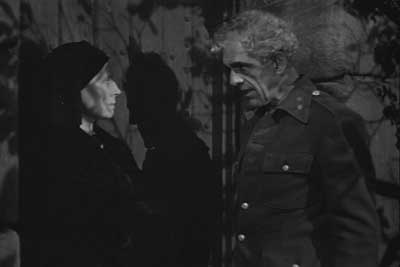
"Let’s see those bells, St. Mary…"
Strictly speaking, Isle of the Dead works most of the time, due to Director Mark Robson and Val Lewton’s insistence on the atmospheric qualities (shadows that trail off into the background, evil lines, and lurking suspicions) that elevate a somewhat B-picture into this eerie work of suspense and frightening realizations. The Isle is a place of lingering fog; a Mausoleum is a dark, dank place with a sadistic sense of when water must drop, and even a Battlefield is a lesson in horrors, as the bodies litter the ground and death carts with ferocity. Robson works well in Lewton’s maxim that whatever’s scariest is best left to the imagination, and several sequences stand out: that of what could be happening around the Vorvolaka, when a certain character gets placed in a coffin alive, and even when a ghost happens to be prowling the woods outside the homestead to drive home a point of absolute terror. There are as many hints at what’s occurring through shadows, fog, and music as there are shots actually showing you what’s happening in terms of development. This works as well as it can for its day and age, although nowadays it works because of its effective simplicity.
Another item Lewton peppered into his films was this sense of fate interlocking all of these characters that came together. Isle of the Dead is no exception. Like The Leopard Man, this film has Karloff and company resigned to their own fate, as they must slowly watch the Plague grip onto their lives and do with them what it must. Since there is no stopping it (save for ending your own life), Lewton and Robson’s film has fate almost as if it’s another character. More specifically, in the wake of the narcolepsy woman, who informs Karloff to make sure when it’s lights out for her that he checks her pulse. She could, hypothetically, stop breathing normally, and thus have the preceding official pronounce her dead. It’s all explained quite matter-of-factly, but in terms of fate, it’s a given that at some point this occurrence will make landfall. Even Karloff and the others often discuss their own doom regularly, and fate is as present when a character dies when one lives. It’s the interwoven fabric that almost holds the developments together.
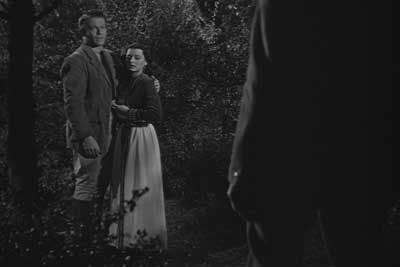
"Listen, if you want a threesome, get in line!
It starts right behind Rick Santorum!"
In short, Isle of the Dead is a relatively slow moving film. That’s what works best about it, as it takes its time in developing atmosphere and character in order to come to the hard conclusions at the end of the film. It’s not particularly frightening, just evilly unsettling.
Isle of the Dead – 8.2 out of 10
Victorian drama in a Lewton film? That was the first thought to spring forth when viewing Bedlam, which fires off etchings of Victorian England in its first moments. They have this endearing timelessness and weirdness to them, almost encapsulating what you’re about to see in 1761 – The Age of Reason. As such, it’s a necessity that Karloff sports a terrible wig, one that carries with it some tricky intentions and a dictionary for a tongue, while ruling over his notorious band of invalids with an iron fist while behind him, his hand in the Government’s pocket.
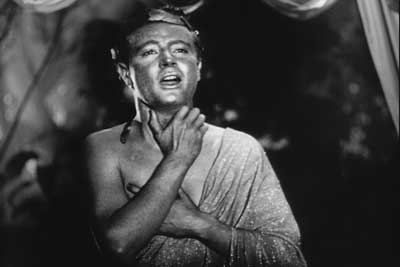
"Auric … Goldfinger … he’s the man…
the man with … the golden touch!"
A man scaling his Asylum walls plunges to his death and society couldn’t seem to care less, that is until a firebrand mistress of a local Government Official – Nell Rowan (played by Anna Lee) – decides to check into the relative facts surrounding Karloff’s own St. Mary’s of Bethlehem, known as Bedlam for short. But her overlord wants these Bedlamities to perform first at a local dinner party he’s holding, so naturally Karloff obliges – wishing to "prepare a mask of greatness that will make him howl." Speaking of which, the stilted dialogue is as much a part of this film as the Vorvolaka was of Isle of the Dead. Both need one another to coalesce and be as truthful to the spirit of the times as possible.
During this dinner party Nell gets incredibly upset, much to Karloff’s George Sims’ chagrin. Perhaps it was the moment where Sims’ cronies paint a young innocent boy in golden guild, much like Auric Goldfinger, only leaving no open spot to breath. The boy dies in a fitful rage, and the dinner guests only chuckle it off, a grossly largesse situation that instills the values of tolerance and fighting injustice to Nell. The Government Official who Nell ‘served’ (this could only be hinted at during this era) is outraged, so he plots a plan with Karloff to have her incarcerated into Bedlam’s hallowed halls. Surely that will teach her. Suddenly, against her will, she finds herself up against a tribunal for which the punishment has already been decided, via Sims’ thoughts. No amount of boasting or quick-witted thinking is going to get Nell out of Bedlam‘s clutches.

"You are teh sux! You have been pwned!"
Off she goes, into the ramshackles and chains of Bedlam, where Sims’ takes some extra-special care of her, consistently making sure her stay is as painless as possible, if you know what he means. Although Karloff misunderestimates Nell’s resolve, and the real fun begins when she’s able to round up a couple of the more sane members living underneath Bedlam‘s creaky roof and quickly arranges to get back at Karloff’s scheming Government lothario.
Bedlam is a period picture, from the dialogue all the way down to the whigged-out costumes and grimy sets, including that of the famed open room where Karloff’s patients are placed together. In attempting to stress the psychological aspects of what represents a crazy person in the public’s eye, the filmmakers – in this case Mark Robson and Lewton, again – somewhat place the relatively frightening aspects of items on the backburner. In its place is a rather finger-wagging indictment against the evils of such corruption with Government officials, and could also be seen as a case for the Quakers (who are portrayed in such a horrific manner, that you feel for their religious plight), especially through the eyes of the Quaker character whose name escapes my virgin recollections at the moment.

"So I says: you’re my cherry pie. You put a
smile on my face 10 miles wide…"
First is the spectacular performance full of nuance by Karloff. His Sims is a man of sneaky talents, as his ability to rob from everyone to get what he wants is so ingrained into his being, that even when he walks down the street you can see the machinations of dishonesty working their way into the picture. Looking conspicuously like Jeremy Irons, Karloff works with his fake hair, his smirking evil smile, and his cocky strut to make the most out of Sims, a faux-Socialite with dark tendencies against those who would question his resolve towards what Society doesn’t want to deal with. He might feel like he’s doing nothing wrong, and with Karloff at the helm, Sims’ is a devilish character filled with malice.
Secondly, Robson and Lewton continue to ratchet up the tension in the most unlikeliest of places, from dinner parties to unquestionable tribunals, and most notably the shadowy halls of Bedlam‘s big room. There’s an atmosphere at stake here, one where one moment is as cheerful and airy as anything else you’ve seen (outside) and one that’s as sadistic and dark and suspect as you’ve seen since then (inside). The two are an almost perfect balance of the two-faces of society, against which its ills have been known to cause pain even for those sane (here’s looking at you – and me! – kid…). What works so tremendously well for Robson and Lewton are their hammer skills. They’ve nailed down the period frighteningly well; the language and the scheming actions of all those involved, that audiences back then were most certainly frightened at the prospect of having themselves thrown into the brig. Today, though, it’s a time capsule of what Society was like, as opposed to the technology brought into the proceedings now. That’s the scary part.
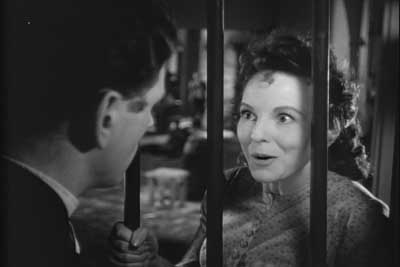
"Did you bring me some Hentai and Yuengling?"
One of the best moments involves something ripped straight from Poe, in terms of boarding someone up, alive, in a wall that’s just being built. As the bricks slowly form higher and higher against the comeuppance of this one being, he slowly opens his eyes. The last brick is quickly placed over his wide-eyed surprise; the resounding thud languishes for eternity. It’s a frightening shot, one that still reverberates decades later. Another wondrous moment comes when Neil realizes upon waking up where she is. The camera starts out slowly on her face and subsequently pulls back, all the way back, revealing the innate destitute around her: bodies lying, moaning, and hay everywhere. It’s a great stunning shot, one that Spielberg used semi-faithfully for tremendous effect in the basket square sequence in Raiders of the Lost Ark.
And while those moments don’t happen very often, Bedlam is still an entertaining film punctuated with a great Karloff performance that rivals anything else he’s ever done before or since then.
Bedlam – 8.4 out of 10
The Look
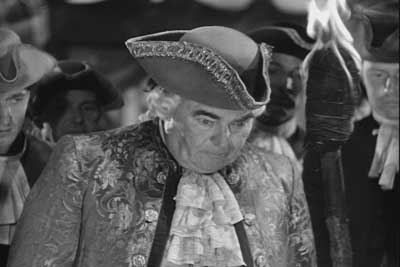
Usually pantsless, Frank always succumbed to
the heckling of small penis talk.
If you’ve ever purchased another one of Warner’s older films, you’ll know that the transfers themselves are fairly excellent, considering how old these films are. Both films are presented in their original 1.37:1 aspect ratio, preserving the filmmaker’s original intent (I wouldn’t have it any other way!). There are no glaring image artifacts that will detract from your viewing, although Bedlam does have a few scratches and pieces of dust here and there. Isle of the Dead does contain a fair amount of filmic artifacts from the print they used, but it’s nothing major to distract from your viewing pleasure. Be joyous that they’ve seen fit to keep all sides happy.
Isle of the Dead – 8.5 out of 10
Bedlam – 8.7 out of 10
The Noise
Dolby Digital 1.0. Your center channel won’t feel any sort of burn, but the track for Isle of the Dead is sweet enough for you to hear everything from the dialogue to the haunting musical score to the Vorvolaka. Bedlam, on the other hand, suffers from the same fate, that of being a good aural soundtrack for your system. High time to shake your fists to the heavens, yelling ‘curses!’.
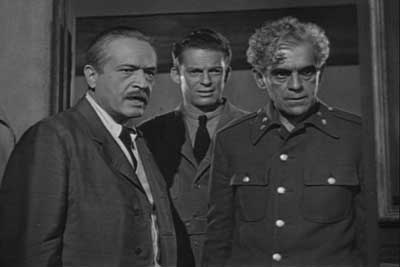
"I never understood why they needed 4 tentacles…"
Both – 8.0 out of 10
The Goodies
Sadly, most of the films in the Val Lewton Horror Collection don’t contain extras. Isle of the Dead doesn’t contain its reissue trailer, which allegedly has Karloff exclaiming not to leave the Island over and over and over some more, which would have been good to see. Maybe even a featurette with some filmmakers/film historians discussing why Lewton’s films are so beloved and the high-water mark for the psychological horror genre, but you get – as Willy Wonka once exclaimed – nothing!
Bedlam comes with an informative audio commentary from Historian Tom Weaver, in which he vociferously packs a variety of fairly unknown (to today’s more inept audience member) information to your quivering ears. There’s thousands of great tid-bits scattered throughout his vast array of rapid-fire comments, everything from Lewton taking pot-shots at Universal’s famed classical Horror output, to Lewton’s Technicolor extravaganza of the vampire epic Carmilla, which fizzled out before it even began. All in all, this track is highly recommended for those wishing to learn about Lewton’s relatively unknown stature from a man that doesn’t seem to understand the meaning of the words slow down.
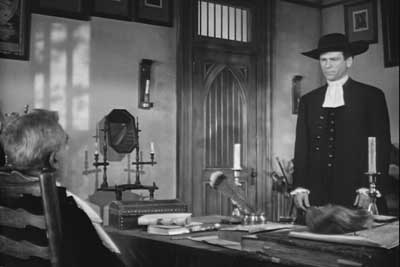
"So, is your Oatmeal as good as Brimley says?"
Isle of the Dead – 0 out of 10
Bedlam – 5.5 out of 10
The Artwork
Keeping firmly in check with the other Lewtons in the collection. I find them stunning in a very nostalgic way. The imagery against the white really makes these terror-ific tales really stand out in retrospect, especially with someone as ghastly and iconic as Boris Karloff providing his necessary gloom and doom against those unwilling (in these films’ case, females) to be fooled into his charms. Isle of the Dead continues Lewton’s fascination with hands, being the dreadful items that they are, with Karloff reaching out, à la I Walked with a Zombie, to place you in his world. Bedlam‘s most distinctive feature is the small scene of Karloff and his "white dove" in the bottom right hand corner, bringing the right amount of malice into the one-sheet of insanity.
Both – 9.0 out of 10
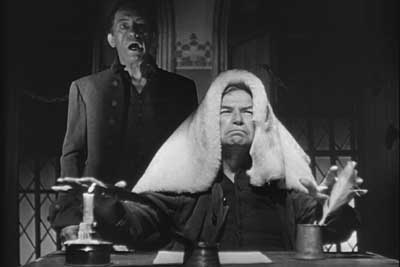
Isle of the Dead – 6.7 out of 10
Bedlam – 7.9 out of 10
